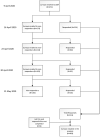Stress, Resilience, and Coping of Healthcare Workers during the COVID-19 Pandemic
- PMID: 33834900
- PMCID: PMC8040550
- DOI: 10.1177/21501327211008448
Stress, Resilience, and Coping of Healthcare Workers during the COVID-19 Pandemic
Abstract
Objective: To estimate the health care workers (HCWs) self-reported stress, resilience, and coping during the COVID-19 pandemic, and to determine inter-professional differences.
Participants and methods: An email survey was sent to 474 HCW at a Midwestern HealthCare facility between April 9, 2020 and April 30, 2020. A total of 311 (65.6%) responses were received by May 31, 2020. The survey utilized 3 validated instruments: Perceived Stress Scale (PSS), Brief Resilience Scale (BRS), Brief Resilience Coping Scale (BRCS).
Results: Of the 311 responses, 302 were evaluated: 97 from nonmedical staff with patient contact (NMPC); 86 from nonmedical staff with no patient contact (NMNPC); 62 from medical doctors (MD), physician assistants (PA) and nurse practitioners (NP); and 57 from nurses. Significant differences were noted across job categories for stress and resilience, with nurses reporting highest PSS scores (effect estimates: -2.72, P = .009 for NMNPC; -2.50, P = .015 for NMPC; -3.21, P = .006 for MD/NP/PA respectively), and MD/NP/PA group with highest BRS scores: nurses (-0.31, P = .02); NMPC (-0.3333, P = .01); and NMNPC (-0.2828, P = .02). Younger personnel had higher stress (-1.59 per decade of age, P < .01) and more resilience (0.11 per decade of age, P = .002).
Conclusion: These self-reported data indicate that MD/NP/PA had the highest resilience scores and the nurses had highest stress levels. Efforts are warranted to include all HCWs in systematic stress mitigating interventions with particular attention to understand specific factors contributing to stress for the nursing team.
Keywords: SARS; healthcare; pandemic; provider; resilience; stress.
Conflict of interest statement
Figures
References
-
- World Health Organization. Archived: WHO Timeline - COVID-19. Updated April 27, 2020. Accessed July 17, 2020. https://www.who.int/news-room/detail/27-04-2020-who-timeline—covid-19?gc...
-
- Center for Disease Control and Prevention. New ICD-10-CM code for the 2019 Novel Coronavirus (COVID-19), April 1, 2020. Published 2020. Updated March 18, 2020. Accessed July 17, 2020. https://www.cdc.gov/nchs/data/icd/Announcement-New-ICD-code-for-coronavi...
-
- Greenberg N, Docherty M, Gnanapragasam S, Wessely S. Managing mental health challenges faced by healthcare workers during covid-19 pandemic. BMJ. 2020;368:m1211. - PubMed
-
- American Psychological Association. Building your resilience. Published 2012. Updated 2020. Accessed July 15, 2020. https://www.apa.org/topics/resilience
Publication types
MeSH terms
Grants and funding
LinkOut - more resources
Full Text Sources
Other Literature Sources
Medical
Miscellaneous



